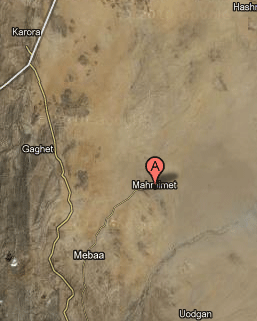| |
Tuku'e Yehadego was born in Asmara around 1942. He attended high school at Haile Selassie I secondary school, where he was a leading figure in the 1957 student strike against the imposition of Amharic as the school's language instruction. During the student demonstration in 1957 he hit a police captain with his head and was arrested.
Tuku'e was also a soccer star player, after graduation he played with the Adulis Footbal Club and in December 1959 when the team was playing in Port-Sudan, he was recruited into the Eritrea Liberation Movement (Haraka). According Iyob (1995, 101) the Eritrean team, Adulis travelled to the Sudan for national matches, and three ELM members mobilized and recruited members for the new organisation. Killion (1997, 53) also adds that Tuku'e later helped organize the ELM in Asmara. Team members, like Tuku'e played key roles in spreading the network among the youth in Asmara in 1959 and he became a key ELM organizer in Asmara where he worked for Civil Aviation Authority. Tuku’e was also recruited the Eritrean Chief Police General Tedla Ogbit who was active in the assembly intimidating members and interrogated ELM (Haraka) members in the late 1950s. However, Tedla repented later and attempted to join the Eritra resistance movement this could be after he was recruited by the ELM. Because of this development (connection) when Tuku’e was arrested for organising a demonstration against Eritrea ANNEXATION in late 1962 he was released by Police General Tedla Ogbit.
After Tuku’e released from a prison in late 1962, he fled to Sudan to continue his struggle against the annexation of Eritrea in 1962 and he worked with the ELM until its demise by the ELF in 1965. Following the liquidation of the military wing of the ELM in 1965, Turku’s joined the ELF without trying to revitalize the ELM or create a new organisation. However when Wolday Giday and Kidane Kiflu, two prominent ELF members were killed in Kassala by the ELF in 1969, he joined Osman Saleh Sabbe’s organization, in 1970
The death of Kidane caused much disillusionment among the ELF fighters. For example Tuku Yehdego who was one of the founders ofMahber Mahber Shew'ate (Union of Seven) in Asmara in 1959 became disillusioned. Tuku hated the Kiada al Ama leadership from the beginning and decided to work with the Sabbe group rather than to join Selfi Nsenat which was led by Issayas who was member of Kiada al Ama until he defected to theAla groups on 27 April 1970.
After Tuku left the ELF, he sent a letter to the Eritrean students and other former members of Haraka in the Diaspora to inform them about the unstable political situation in the ELF and the Kiada Al Ama conspiracy to kill Kidane Kiflue and other fighters. His letter might have contributed for the split among the Eritrean students in the diaspora at the meeting of General Union of Eritrean Students (GUES) in Munich in the summer of 1970. One group was, which had Dr Fitsum Ghebreselassie, Aregai Habtu, Habte Tesfamariam etc condemned the Kiada al Ama action and the other group, which had, Herui Tedla Bairu who didn't condemn the killing of Kidane Kiflue and Wlday Giday. In 1971 when Dr Fitsum Ghebreselassie was killed in the ELF, Herui Tedla Bairu was a vice-chairman in 1971. The killing of Dr Fitsum Ghebreselassie might have a connection with the summer meeting which was held in Munich . [Herui was also participated in the decision to liquidate the EPLF in1972 which caused for the death of 3, 000 fighters from both side between 1972 and 1974. This was another crime which committed when he was in the ELF leadership between 1971 and 1975.]. It is beyond the scope of this paper to explore this issue in greater depth.
When Tuku’e was working between Aden and Sudan in the early 1970s, he wrote unpublished paper under the title( ገድሊ ኤርተራ መዓስ ተጀመረ? ብመንከ? The main theme of this paper was just to make aware of the Eritrea people struggle how it was started and when. In this well written paper he made clear that the Eritrea people struggle was started in the 1940s and 1950s not in 1961. However, it was sad Tuku'e was killed before transferring his experience and knowledge to the young generation in 1971. This was presuming before 15.6.71 as he had a plan to attend the EPLF meeting on that date. For further information refer the last page of his paper ገድሊ ኤርተራ መዓስ ተጀመረ? ብመንከ?
 |
Regarding his death Killion (1991: 413 p.) in his book mentioned that Tuku was killed in an ELF ambush in 1971 while bringing supplies from Port-Sudan to ELF-PLF fighters in Sahel, this was based on the EPLF story
However, according to a reliable source Tuku'e did not die in the civil war but there was a story that he mysteriously disappeared while he was with Girmai.
In 1971 Teku vanished without trace somewhere around Mahmimet (See map.1) while he was on the journey with Girmay Mahari from Port Sudan to Semenaw Bahari (See map.2) to attend the EPLF meeting which was held on 15-6-1971 at Semenaw Bahari inside Eritrea |

MAP1
|

MAP 2
|
Tuku was not only very naïve in making the decision to attend the EPLF meeting but also in trusting Girmay Mahari and travelling with him. Regarding this incident Girmay Mahari reported that they lost each other somewhere around Mahmmimet. Tekey Beyne also mentioned this incident in his book kabriqe -hefeneti Tekie Beyne (2009: p.133). What was reported by Girmay Mehari was just a cover up story similar to what was reported about the death of Abraham Tewelde 1970s, Woldenkile Haile 1977, Mengesteab Yisak 1978, Ibrahim Afa 1985 etc. When Girmay Mahari convinced Tuku to visit the field, Tuku had never thought that he would be the next victim of the EPLF leaders after Abraham Tewelde. If he had returned to Port Sudan after attending the meeting, he would have completed the last part of his paper (ገድሊ ኤርተራ መዓስ ተጀመረ? ብመንከ?)
As history proves Issays has never hesitated to eliminate any one who is more famous than he or a threat to his power and Tuku’e became one of the victim. Girmay Filipos in his paper “ኢሳያስ ሰላዪዶ ወይ ተጋዳሊ also mentioned that Tuke was killed by the EPLF not ELF.
 Based on this paper and others which were written about the EPLF’s History of Mysterious Deaths in the 1970s in past 6 years, one can dare to say that Tuku’e was killed by Girmai Mehari who is the commander of both Sembel and Tsetserat Prison Administration and Rehabilitation Services. The death of Tuku’e is also a victory for Idris M.Adem who was the founder of the ELF in competition with the ELM in 1960 and chairman of the ELF in 1971. According various sources Idris hated the ELM and its members because of their secular views. Regarding this Bereketeab (2000:184) states the leaders of the ELF and Idris Mohammed Adem in particular dislike the strategy of the ELM. Mengesteab (2005:40) also adds that, Idris launched a vitriolic campaign against ELM and its leaders threatened by the youthful and secular orientation of the ELM leadership and by Nawid's early affiliation with the Sudanese Communist Party, Idris Adem roused Eritrean nationalists against the ELM. Based on this paper and others which were written about the EPLF’s History of Mysterious Deaths in the 1970s in past 6 years, one can dare to say that Tuku’e was killed by Girmai Mehari who is the commander of both Sembel and Tsetserat Prison Administration and Rehabilitation Services. The death of Tuku’e is also a victory for Idris M.Adem who was the founder of the ELF in competition with the ELM in 1960 and chairman of the ELF in 1971. According various sources Idris hated the ELM and its members because of their secular views. Regarding this Bereketeab (2000:184) states the leaders of the ELF and Idris Mohammed Adem in particular dislike the strategy of the ELM. Mengesteab (2005:40) also adds that, Idris launched a vitriolic campaign against ELM and its leaders threatened by the youthful and secular orientation of the ELM leadership and by Nawid's early affiliation with the Sudanese Communist Party, Idris Adem roused Eritrean nationalists against the ELM.
Tuku’e was one of the great young personalities of the post-Italian colonial generation who spent his youth in struggling to preserve the federal constitution by leading student demonstrations and actively participating in spreading the ELM networking, helping organize a protest against Eritrea ANNEXATION in late 1962.
In this 48th year of commemoration of the beginning of the armed struggle for national liberation, a brave nationalist man like Tuku’s should be remembered as a hero by all Eritrean youth and they should follow his traces to revitalize the spirit of the 1950s youth movement which will be have a great outcome in creating unity among the youth to speed up their victory over the present autocratic government and other leaders within the opposition groups who refuse to acknowledge their crimes or collaboration during the armed struggle. |
|



